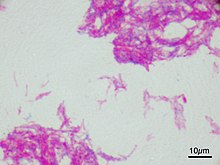Bacillus Calmette–Guérin (BCG) vaccine is a vaccine primarily used against tuberculosis (TB).[4] It is named after its inventors Albert Calmette and Camille Guérin.[5][6] In countries where TB or leprosy is common, one dose is recommended in healthy babies as soon after birth as possible.[4] In areas where TB is not common, only children at high risk are typically immunized, while suspected cases of TB are individually tested for and treated.[4] Adults who do not have TB and have not been previously immunized but are frequently exposed may be immunized as well.[4] BCG also has some effectiveness against Buruli ulcer infection and other nontuberculous mycobacteria infections.[4] Additionally it is sometimes used as part of the treatment of bladder cancer.[7][8]
Rates of protection against TB infection vary widely and protection lasts up to twenty years.[4] Among children it prevents about 20% from getting infected and among those who do get infected it protects half from developing disease.[9] The vaccine is given by injection into the skin.[4] There is no evidence that additional doses are beneficial.[4]
Serious side effects are rare. Often there is redness, swelling, and mild pain at the site of injection.[4] A small ulcer may also form with some scarring after healing.[4] Side effects are more common and potentially more severe in those with poor immune function.[4] It is not safe for use during pregnancy.[4] The vaccine was originally developed from Mycobacterium bovis, which is commonly found in cows.[4] While it has been weakened, it is still live.[4]
The BCG vaccine was first used medically in 1921.[4] It is on the World Health Organization's List of Essential Medicines.[10] As of 2004, the vaccine is given to about 100 million children per year globally.[11]
 Microscopic image of the Calmette-Guérin bacillus, Ziehl–Neelsen stain, magnification: 1,000nn | |
| Vaccine description | |
|---|---|
| Target | Mycobacterium tuberculosis |
| Vaccine type | Attenuated |
https://en.wikipedia.org/wiki/BCG_vaccine
above.
No comments:
Post a Comment